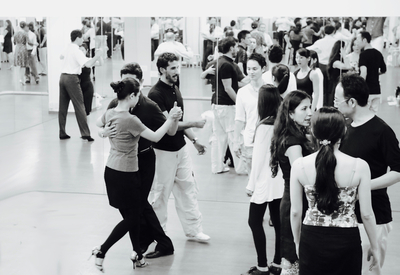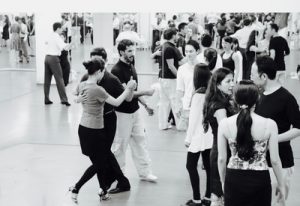タンゴを上達にするには何が一番大事か?
それは”練習”です。
マエストロ カルロス・リバローラも多くのタンゴダンサーも「Practica,Practica(練習、練習)」と言います。
これは他のこともそうかもしれません。
TED EDに効果的な練習についての動画ありNさんのご協力のもとその内容を翻訳しました。
さぁ〜スマホを置いて練習をしよう!
*下にこの動画があります。
効果的な練習の方法
効果的な練習の方法:
どんなことについてもです。どんな身体的スキルにについても;
バレエのピルエット(回転)を行うこと、
楽器を演奏すること、野球でボールを投げること
練習というのは進歩する目標意識を持って行う動作で、
これは自然な動きでスピーディに自信を持って
身のこなしが出来ることの助けになります。
成功体験を筋肉に覚えさせる
それどは練習すると私たちの脳のなかでは、
「上達している感」がどのように作られるのでしょう。
私たちの脳は二つの神経組織を持っています。
灰白質と白質です。
灰白質は脳の情報処理をします。
いろいろな外部からの反応や感じ方を神経細胞に取り込みます。
白質は脂質組織と神経線維からできています。身体を動かすためには、
脳の灰白色質から情報が軸索と呼ばれる神経線維の
連携を通して脊椎に行き筋肉に伝わります。
では、練習を繰り返すことで、私達の脳の見えない働きにどう作用するのでしょうか?
白質にある軸索は、脂肪物質である、
ミエリン鞘と呼ばれるものに覆われています。
そして、神経線維を覆っている、
このミエリン鞘が練習によって変化するようなのです。
ミエリン鞘は電線ケーブルに似ています。
それは、脳が送り出す電気信号のエネルギー消費を抑える役割をします。
電気信号(シナプス)が神経経路を効率良く動くためです。
最近のマウス(鼠)を使った実験では、練習を繰り返すことで、
軸索をカバーするミエリン鞘の厚みが増すことが示されています。
そして、厚みが増せば増すほど強力に絶縁されて守られ、軸索はまるで、
超高速道路を突っ走って情報を脳から筋肉に伝達します。それでアスリートやパーフォマーは
彼らの成功体験を筋肉に覚えさせるのです。
ターゲットを絞る
筋肉自体に記憶があるとはいえません。それはたぶん、
超高速化した神経経路がアスリート、パフォーマーの最新限界値を与えるのでしょう。
どんどん速くなり、効果的になってきた神経経路によって。
一つの技を習得する練習にどのくらいの時間、日にち、年月がかかるのかという、
たくさんの理論が試されてきました。
どのくらいかかるのか、それを数値にすることはできていませんが
私たちは(練習の)苦労は単に練習の時間だけではないことを知っています。
それは、その練習の効率の良さ、質によるものでもあるのです。
効果的な練習は継続的、目標に集中する、
そして自分の今の能力の最高値にある内容(の良し悪し)、
弱点にターゲットを絞ることです。
効果的な練習方法
もし、効果的練習が要であるとしたら、
練習時間により多くの成果を得るにはどうしたらいいのでしょうか?
パソコン、スマホ、特にFBは(受信音、返信待ち)諸悪の根源です。
(気を散らす)スイッチは切りましょう。
まずはゆっくり、スローモーションな動きで始めます。
正しい動き、悪い動きにしろ、繰り返すことで(身体に)協調性が作られます。
繰り返し練習のスピードをだんだん上げていくことで、
正しく動く確率は高くなります。
次に、おおくの繰り返し練習ではユニットごとに
休憩を取ることがエリートパーフォーマーの習慣になっています。
研究ではおおくのトップアスリート、ミュージシャン、ダンサーは
彼らの技を磨くため一週間に50〜60時間を費やしていることがわかりました。
動作をイメージしただけでうまくできる
そのうちの多くが、毎日の練習を時間を決めて
何回かに分けて効率の良い練習をしています。
そうして、結果的に脳は活発な練習を保てるのです。
驚くかもしれませんが、一度身体が運動を身につけると、
その動作をイメージしただけで、うまくできることもあることが
いくつかの研究で示されています。
144人のバスケット選手を二つのグループに分けた研究があります。
Aグループは実際に片手のフリースローの練習をしてもらい、
Bグループでは、頭の中だけで、練習してもらいました。
そして、2週間の実験の終わりに実際に(フリースロー)のテストをしてみると、
中級と上級者のプレイヤーでは二つのグループの上達はほとんど同じでした。
科学者が脳の秘密を解明していくと、
効果的練習が唯一上達の道であることが分かります。
今のところ、効果的練習法が、私たち個人の限界、新しい高みへの達成、
そして私たちの可能性を最大限に引き出す一番の方法なのです。
https://www.facebook.com/TEDEducation/videos/1489398127740055/
https://www.facebook.com/TEDEducation/videos/1489398127740055/
原文
How to practice effectively
For just about anything, Any physical skill performing
being it a pirouette
playing an instrument or throwing baseball
takes practice and it helps us perform with more ease, speed and confidence.
So what does practice doing our brains to make us better at things.
Our brans have two kinds of neural tissue:Grey matter and white matter.
Grey matter is directing signals and sensory stimuli to neuve cells,while whit matter is mostly made up of fatty tissue and neuve fibers.
In order for our body to move,information needs to travel from the brain’s grey matter down the primal cord through a chain of neuve fibers celled axons, to our muscles.
So how does practicer of repetition affect the inner working of our brains?
The axons that exist in the white matter are wrapped with a fatty substance called myelin.
And it’s this myelin covering or sheath that seems to change with practice.
Myelin is similar to insulation on electoral cables.
It prevents energy loss from electrical signals that the brain uses,
moving them more effecientlly along neural pathways.
Some recent studies in mice suggest that the repetition of physical motion increases the layers of myelin sheath that insulates the axons.
And the more layers, the greater the insulation around the axon chains, forming sort fo superhighway for information. connecting your brains to your muscles.
So while many athletes and performers attribute their successes to muscle memory.
Muscles themselves don’t really have memory.
Rather, it may be the mylination of neural pathways that gives these athletes and performers their edge with faster and more efficient neural pathways.
There are many theories that attempt to qualify the number of hours, days, and years of practice that it takes to master a skill.
While we don’t yet have a magic number, we do know that misery isn’s simply about the amount of hours of practice.Its also the quality effectiveness of that practice.
Effective practice is consistant, intensely focused and targets content or weaknesses that lie at the edge of one’s current abilities.
So if effective practice is the key how can we get the most out of our practice time?
Laptops, smartphones, and particularly Facebook were the root of most distractions.
Start out slowly or in slow-motion.
Coordination is built with repetitions, whether correct or incorrect.
If you gradually increase the speed of the quality repetitions, you have a better chance of doing them correctly.
Next, frequent repetitions with allotted breaks are common practice habits for elite performers.
Studies have shown that many top athletes, musicians and dancers spend 50 – 60 hours per week on activities to their craft.
Many divide their time used for effective practice into multiple daily practice sessions of limited duration.And finally, practice in your brain in vivid detail.
It’s a bit surprising, but a number of studies suggest that once a physical motion has been established, it can be reinforced just by imagine it.
In one study, 144 basketball players were divided into two groups.
Group A physically practiced one-handed free throws while Group B only mentally practiced them.
Then they were tested at the end of two week experiment, the intermediate and experienced players in both groups had improved by nearly the same amount.
As scientists get closer to unraveling the secret of our brains, our understanding of effective practice will only improve.
In the meantime, effective practice is the best way we have of pushing our individual limits, achieving new heights, and maximizing our potential.
翻訳をしてくれたNさんありがとう!


